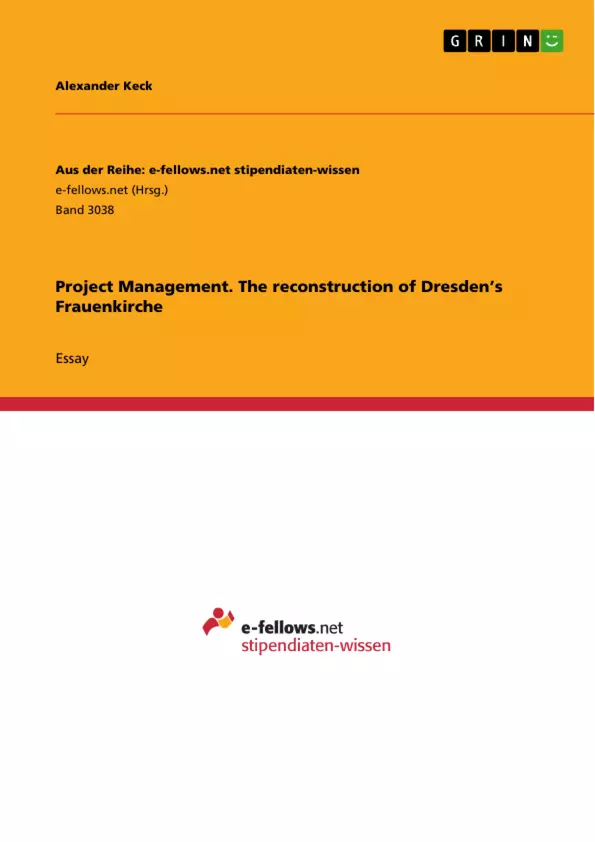It was one of the finest baroque churches in the world (Meg, 1998) in a city that is known as “Florence of the Elbe”, dominating the skyline since its completion in 1743 (Furlong, 2004): The Frauenkirche (“Church of Our Lady”) in Dresden, Germany. Unfortunately, the church was destroyed in 1945, when Allied bombers attacked the city and killed around 100,000 inhabitants (Connolly, 2005; Meg, 1998) in response to the Germans bombing the City of London. After the blackened ruins had laid for decades (Connolly, 2004), the church was reconstructed between 1994 and 2005 based on a civilian initiative that aimed to create a symbol for reconciliation and peace (Furlong, 2004).
This report aims to sketch the major characteristics of the according project and the lessons that can be learned from its realisation. It thereby draws on major project management tools and frameworks in the following categories:
- Project description, vision and strategy
- Challenges
- Project stakeholders
- Project risks
- Lessons learned
Inhaltsverzeichnis (Table of Contents)
- Introduction
- Project description, vision and strategy
- Special challenges
- Technology - High-tech
- Novelty - Platform
- Complexity - System
- Pace Regular
Zielsetzung und Themenschwerpunkte (Objectives and Key Themes)
This report focuses on the reconstruction of Dresden's Frauenkirche, a renowned baroque church destroyed in 1945. The report analyzes the project's objectives and key challenges, highlighting the lessons learned from its successful realization.
- Reconstruction of the Frauenkirche as a symbol of reconciliation and peace
- Integration of traditional techniques with modern technologies
- Utilization of historic building materials
- Collaboration of international partners
- Successful project management within defined budget and time constraints
Zusammenfassung der Kapitel (Chapter Summaries)
The introduction provides background information on the Frauenkirche and its destruction during World War II. It sets the stage for the subsequent discussion of the reconstruction project, highlighting its significance as a symbol of reconciliation and peace.
Chapter 2 delves into the project's vision and strategy. It discusses the “Call from Dresden”, a civilian initiative that formulated the vision for the reconstruction. The chapter also explores the four main goals of the initiators: re-using historic materials, ensuring the building's vibrant usage in the 21st century, combining traditional techniques with modern technologies, and involving international partners in the fundraising effort. The chapter concludes with an overview of the project's implementation and the establishment of the “Society to Promote the Reconstruction of the Frauenkirche” and the “Foundation Frauenkirche Dresden” to manage the project.
Chapter 3 explores the special challenges faced during the reconstruction project. It utilizes the “Diamond Framework” by Shenhar & Dvir (2007) to analyze the technological, novelty, complexity, and pace dimensions of the project. The chapter focuses on the challenges posed by combining traditional and modern technologies, using historic materials, and managing the complex project structure. It also highlights the project's success in meeting its targets despite these challenges, including the completion of the reconstruction one year ahead of schedule.
Schlüsselwörter (Keywords)
The core focus of this report lies in the reconstruction project of Dresden's Frauenkirche. Key keywords include project management, reconstruction, historic building materials, traditional techniques, modern technologies, reconciliation, peace, and the “Diamond Framework” by Shenhar & Dvir (2007). The report explores the lessons learned from the project, highlighting its success in meeting the objectives and overcoming significant challenges.
- Quote paper
- Alexander Keck (Author), 2017, Project Management. The reconstruction of Dresden’s Frauenkirche, Munich, GRIN Verlag, https://www.grin.com/document/455060




